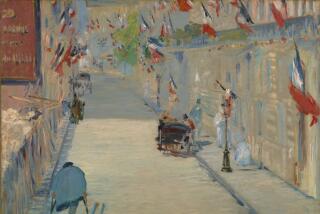Lost and found
SINCE the 1973 publication of his first book, “Wisconsin Death Trip,” Michael Lesy has staked out a position as a photographic anthropologist, an archivist collecting images of long-gone worlds. His 1997 collection, “Dreamland,” gathers more than 200 pictures from turn-of-the-20th-century postcards, and his “Long Time Coming” mines the archives of the Depression-era Farm Security Administration to frame a vision of America between 1935 and 1943.
Lesy’s latest effort, “Angel’s World: The New York Photographs of Angelo Rizzuto” (W.W. Norton: 128 pp., $35), continues this cultural reclamation process. Rizzuto, he tells us in an evocative introductory essay, was a loner who between May 1952 and June 1966 went out at 2 p.m. every day to shoot on the streets of New York.
After his death in 1967, the unknown Rizzuto “left 60,000 photographs and $50,000 to the Library of Congress.” These photographs record a succession of faces -- women mostly -- as well as certain recurring motifs: “40 pictures of the urn in front of the Public Library; 30 pictures of Christopher Columbus; 250 pictures of the Statue of Liberty. Cityscapes photographed for ten years from rooftops and then from rented small planes and helicopters,” Lesy writes. “Angel’s World” features 98 images that offer a representative sample of Rizzuto’s vision, in which New York becomes a kind of template, an exterior expression of the inner life.
In some ways, “Angel’s World” can be viewed as a historical document -- all those images of a lost city, in an increasingly distant century -- or as the portrait of one man’s obsession, an obsession that played itself out from behind a camera lens. But neither of these readings is accurate, or at least, not accurate enough. No, this is an excavation of the city as soul mirror, one Rizzuto held up to New York every day for 14 years. Here, we discover the loneliness of both the photographer and his subjects, their distance and their longing all at once. It’s a longing Rizzuto tried to reconcile but could not, and we see it in his self-portraits, which he began to shoot, turning the camera back on himself at arm’s length, in 1953. Yet even more, it is in the aching emptiness of his street scenes (two boys riding a bicycle down a sparsely peopled avenue, a window dresser undressing a female mannequin) that he reveals himself, one man alone in a city that will not recognize him, even as he uses it to recognize himself.
-- David L. Ulin
More to Read
Sign up for our Book Club newsletter
Get the latest news, events and more from the Los Angeles Times Book Club, and help us get L.A. reading and talking.
You may occasionally receive promotional content from the Los Angeles Times.









